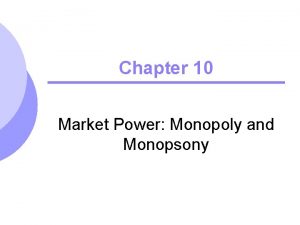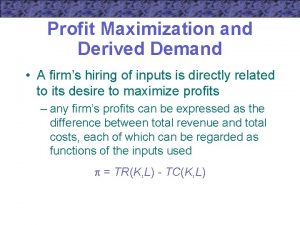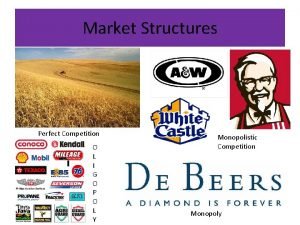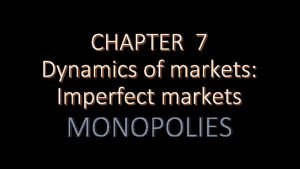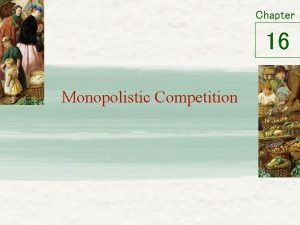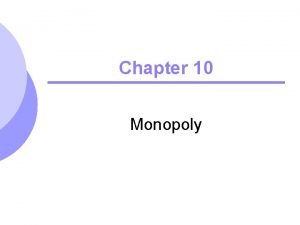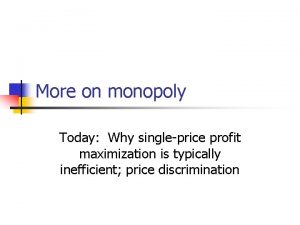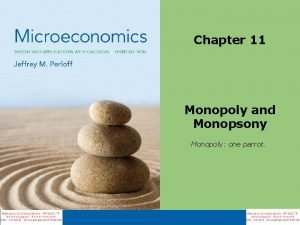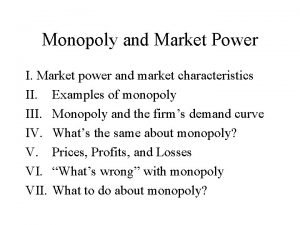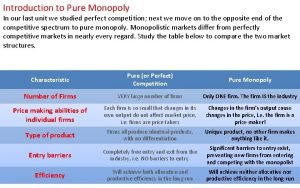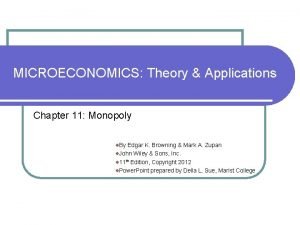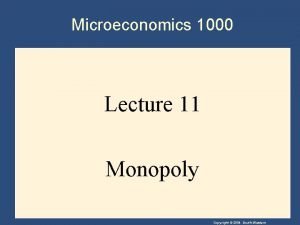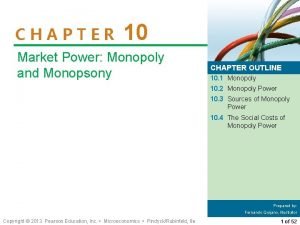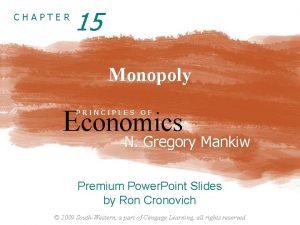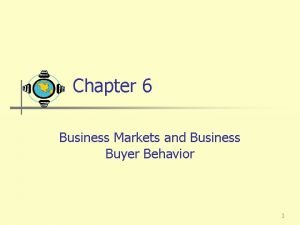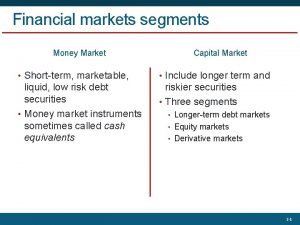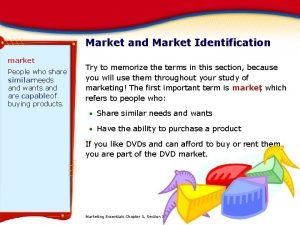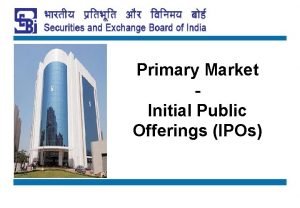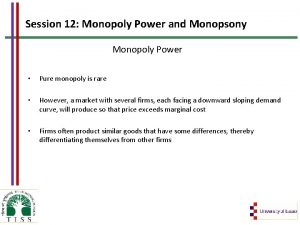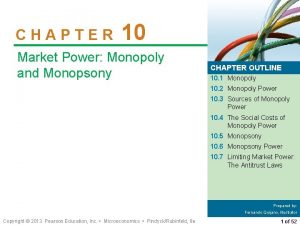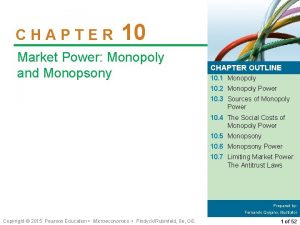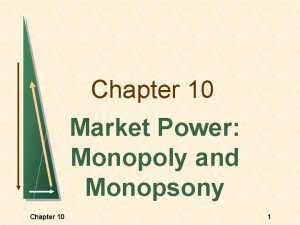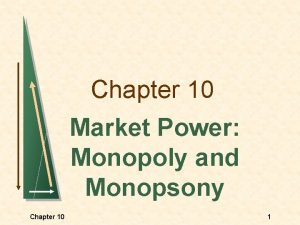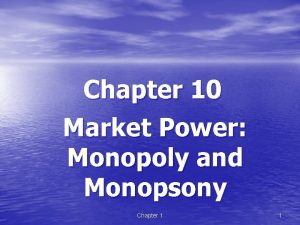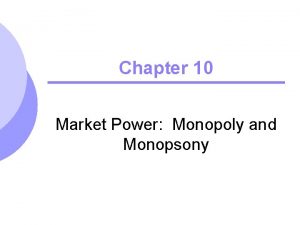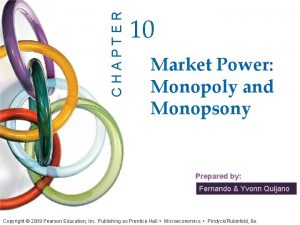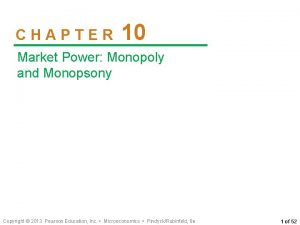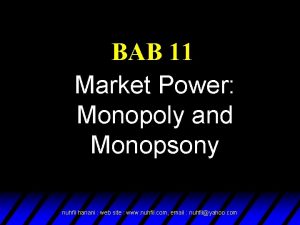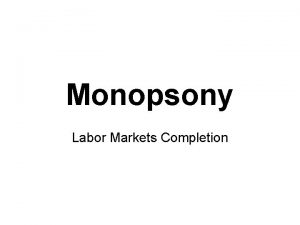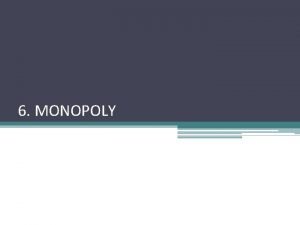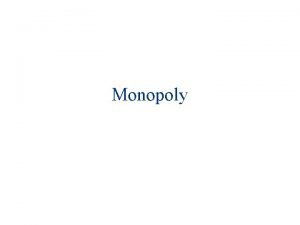Chapter 9 Market Power Monopoly and Monopsony Chapter




























- Slides: 28

Chapter 9 Market Power: Monopoly and Monopsony Chapter 9 Slide 1

Perfect Competition n Review of Perfect Competition l P = LMC = LRAC l Normal profits or zero economic profits in the long run l Large number of buyers and sellers l Homogenous product l Perfect information Chapter 9 Slide 2

Perfect Competition Market P D P S Individual Firm LMC P 0 Q 0 Chapter 9 Q LRAC MR = P q 0 Q Slide 3

Monopoly n Monopoly 1) One seller - many buyers 2) One product (no good substitutes) Chapter 9 Slide 4

Monopoly n The monopolist is the supply-side of the market and has complete control over the amount offered for sale. n Profits will be maximized at the level of output where marginal revenue equals marginal cost. Chapter 9 Slide 5

Monopoly n Finding Marginal Revenue l As the sole producer, the monopolist works with the market demand to determine output and price. l Assume a firm with demand: u Chapter 9 P=6 -Q Slide 6

Total, Marginal, and Average Revenue Price P Quantity Q $6 5 4 3 2 1 0 1 2 3 4 5 Chapter 9 Total Revenue R $0 5 8 9 8 5 Marginal Revenue MR --$5 3 1 -1 -3 Average Revenue AR --$5 4 3 2 1 Slide 7

Average and Marginal Revenue $ per unit of output 7 6 5 Average Revenue (Demand) 4 3 2 Chapter 9 1 Marginal Revenue 0 1 2 3 4 5 6 7 Output Slide 8

Monopoly n Observations 1) To increase sales the price must fall 2) MR < P 3) Compared to perfect competition Chapter 9 u No change in price to change sales u MR = P Slide 9

Monopoly n Monopolist’s Output Decision 1) Profits maximized at the output level where MR = MC 2) Cost functions are the same Chapter 9 Slide 10

Maximizing Profit When Marginal Revenue Equals Marginal Cost The Monopolist’s Output Decision n At output levels below MR = MC the decrease in revenue is greater than the decrease in cost (MR > MC). n At output levels above MR = MC the increase in cost is greater than the decrease in revenue (MR < MC) Chapter 9 Slide 11

Maximizing Profit When Marginal Revenue Equals Marginal Cost $ per unit of output MC P 1 P* AC P 2 Lost profit D = AR MR Q 1 Chapter 9 Q* Q 2 Lost profit Quantity Slide 12

Monopoly The Monopolist’s Output Decision n An Example Chapter 9 Slide 13

Monopoly The Monopolist’s Output Decision n An Example Chapter 9 Slide 14

Monopoly The Monopolist’s Output Decision n An Example Chapter 9 Slide 15

Monopoly The Monopolist’s Output Decision n An Example l By setting marginal revenue equal to marginal cost, it can be verified that profit is maximized at P = $30 and Q = 10. l This can be seen graphically: Chapter 9 Slide 16

Example of Profit Maximization n Observations l Profits are maximized at 10 units l P = $30, Q = 10, TR = P x Q = $300 l AC = $15, Q = 10, TC = AC x Q = 150 l Profit = TR - TC u $150 = $300 - $150 C $ t' 400 R 300 c 200 t 150 Profits 100 50 c 0 5 10 15 20 Quantity Chapter 9 Slide 17

Example of Profit Maximization n Observations $/Q l AC = $15, Q = 10, TC = AC x Q = 150 40 l Profit = TR - TC = $300 $150 = $150 or 30 l Profit = (P - AC) x Q = ($30 - $15)(10) = $150 MC AC Profit 20 AR 15 MR 10 0 5 10 15 20 Quantity Chapter 9 Slide 18

Monopoly n A Rule of Thumb for Pricing l We want to translate the condition that marginal revenue should equal marginal cost into a rule of thumb that can be more easily applied in practice. l This can be demonstrated using the following steps: Chapter 9 Slide 19

A Rule of Thumb for Pricing Chapter 9 Slide 20

A Rule of Thumb for Pricing Chapter 9 Slide 21

A Rule of Thumb for Pricing Chapter 9 Slide 22

A Rule of Thumb for Pricing = the markup over MC as a percentage of price (P-MC)/P 8. The markup should equal the inverse of the elasticity of demand. Chapter 9 Slide 23

A Rule of Thumb for Pricing Chapter 9 Slide 24

Monopoly n Monopoly pricing compared to perfect competition pricing: l Monopoly P > MC l Perfect Competition P = MC Chapter 9 Slide 25

Monopoly n Monopoly pricing compared to perfect competition pricing: l The more elastic the demand the closer price is to marginal cost. l If Ed is a large negative number, price is close to marginal cost and vice versa. Chapter 9 Slide 26

Monopoly n The Effect of a Tax l n Under monopoly price can sometimes rise by more than the amount of the tax. To determine the impact of a tax: l t = specific tax l MC = MC + t l MR = MC + t : optimal production decision Chapter 9 Slide 27

Effect of Excise Tax on Monopolist $/Q Increase in P: P 0 P 1 > increase in tax P 1 P 0 MC + tax AR t MC MR Q 1 Chapter 9 Q 0 Quantity Slide 28
 Monopsony power diagram
Monopsony power diagram Monopsony profit maximization
Monopsony profit maximization Monopsony
Monopsony Positioning segmentation targeting
Positioning segmentation targeting Monopoly vs oligopoly
Monopoly vs oligopoly Dynamics of imperfect market
Dynamics of imperfect market Difference between perfect competition and monopoly market
Difference between perfect competition and monopoly market Market leader market challenger market follower
Market leader market challenger market follower Market power market failure
Market power market failure Monoply example
Monoply example What is a single price monopoly
What is a single price monopoly Monopoly market examples
Monopoly market examples Features of monopoly market
Features of monopoly market Monopoly in economics
Monopoly in economics Characteristics of monopoly market
Characteristics of monopoly market What is monopoly in economics
What is monopoly in economics Lerner index of monopoly power
Lerner index of monopoly power Lerner index formula
Lerner index formula Social cost of monopoly
Social cost of monopoly Power traiangle
Power traiangle Chapter 15 monopoly
Chapter 15 monopoly Primary target market and secondary target market
Primary target market and secondary target market A model of business buyer behavior
A model of business buyer behavior How to find bond equivalent yield
How to find bond equivalent yield Market identification
Market identification Difference between primary market and secondary market
Difference between primary market and secondary market Commercial bill
Commercial bill Monopolistic competition pictures
Monopolistic competition pictures Advantages of monopoly
Advantages of monopoly
